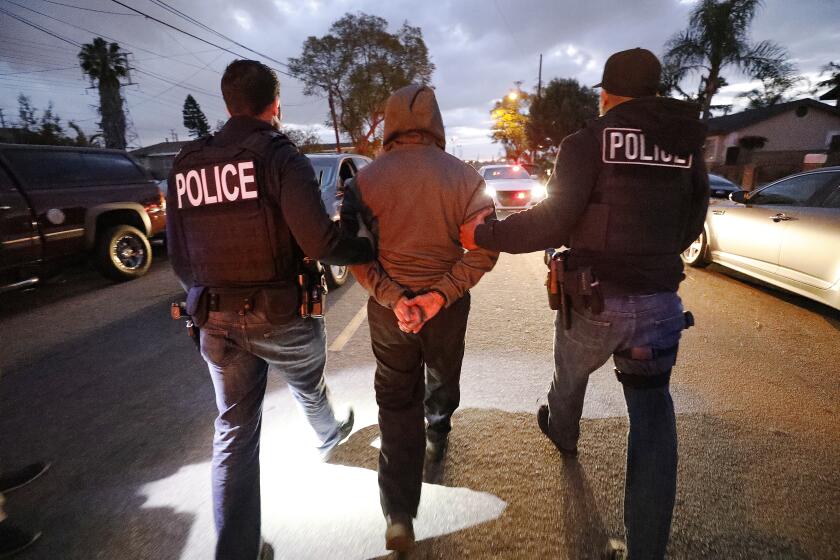Is that an activist judge?
- Share via
WITH THE NEW Supreme Court term set to begin today, judicial activism is again in the news. You remember activism, of course; it’s what President Bush promised to save us from with his Supreme Court nominees, and what John G. Roberts Jr. and Samuel A. Alito Jr. swore to avoid during their confirmation hearings.
Activism, as it’s conventionally understood, is the sin committed when judges decide cases based on their own values rather than the dictates of law. This is an abandonment of the judicial role; it is what is sometimes called “legislating from the bench.”
In one form or another, the specter of activism has been with us for almost as long as we’ve had judges. It’s been raised by both conservatives and liberals, in patterns that tend to alternate depending on whose legislative programs the courts are interfering with. (In the first half of the 20th century, it was the liberal Progressives and New Dealers who shrieked the loudest about it. For the last few decades, we’ve heard mostly from conservatives, but that is starting to change.)
Complaining about activist judges is one of the most consistent practices in American politics -- someone is always doing it. But it is understandable if you feel uncertain about exactly how to identify these monsters. No one knows.
The latest flurry of writing on the topic comes from an attempt by professor Lori Ringhand to offer an objective guide.
Judges are activist, Ringhand suggests, when they vote to strike down state or federal laws, or to overturn a prior judicial decision. This definition is useful because it is objective; it takes away the “I know it when I see it” obscurity of much activism talk. But precisely because it is objective, it’s missing an important part of its meaning. Activism is supposed to be bad, but voting to strike down some laws (unconstitutional ones) is not bad; it’s the judge’s duty.
My suggestion is to stop using the word “activism” entirely.
No one can even agree on which decisions count as activism. And the term is not merely useless, it’s harmful. Because it is almost always used for political effect, it encourages people to think about judicial decisions in political terms and to denounce ones that don’t fit their politics. This corrodes respect for the judiciary and undermines judicial independence. And it shows a very basic misunderstanding of the nature of the American Constitution, which, as Justice Oliver Wendell Holmes wrote, is “made for people of fundamentally differing views.”
Abandoning the word has been suggested before. The problem is that doing so seems to leave us without a way of registering disapproval of inappropriate judicial decisions. This is something we need to be able to do. There are such things as abuses of judicial power and also improper acquiescence to power grabs by the other branches of government. Like the rest of the federal government, the Supreme Court is the servant of the American people, and it is vitally important for the people to be able to evaluate its performance.
I have a suggestion here too. We can decide whether the Supreme Court is behaving appropriately -- whether a particular decision is legitimate or illegitimate -- by deciding whether it is employing an appropriate level of deference to the judgment of other governmental institutions. (This might seem too simple, but if you boil down the complicated doctrines the court has created, most of them turn out to be basically just that: a decision either to defer or to be suspicious.)
Evaluating the level of deference is an easier task than determining whether a decision is correct. It requires us to consider a relatively small number of questions, whose answers suggest greater or lesser deference. Is the constitutional issue one that some other institution is better at analyzing? (Legislatures are better than courts at weighing competing policy concerns and deciding complex factual questions.) Is there some reason to doubt that the political process will give an accurate assessment of the public interest? (The costs of laws that burden politically weak or unpopular groups may be discounted.) Is there a history of constitutional violations by the institution? (States that persisted in racial discrimination were appropriately viewed with suspicion by courts.) What are the relative costs of error? (It’s worse to imprison an innocent person than to release a guilty one.)
Our answers to these questions will not always tell us that the court must use a certain level of deference. Indeed, frequently the answers will point in different directions, suggesting that different choices are reasonable. But that is a feature, not a bug. As long as the court is making a reasonable decision about the level of deference, it is behaving appropriately.
If we examine recent cases from this perspective, we will see that the court is very rarely illegitimate.
Judicial activism turns out to be largely a myth.
More to Read
Get the L.A. Times Politics newsletter
Deeply reported insights into legislation, politics and policy from Sacramento, Washington and beyond. In your inbox twice per week.
You may occasionally receive promotional content from the Los Angeles Times.










